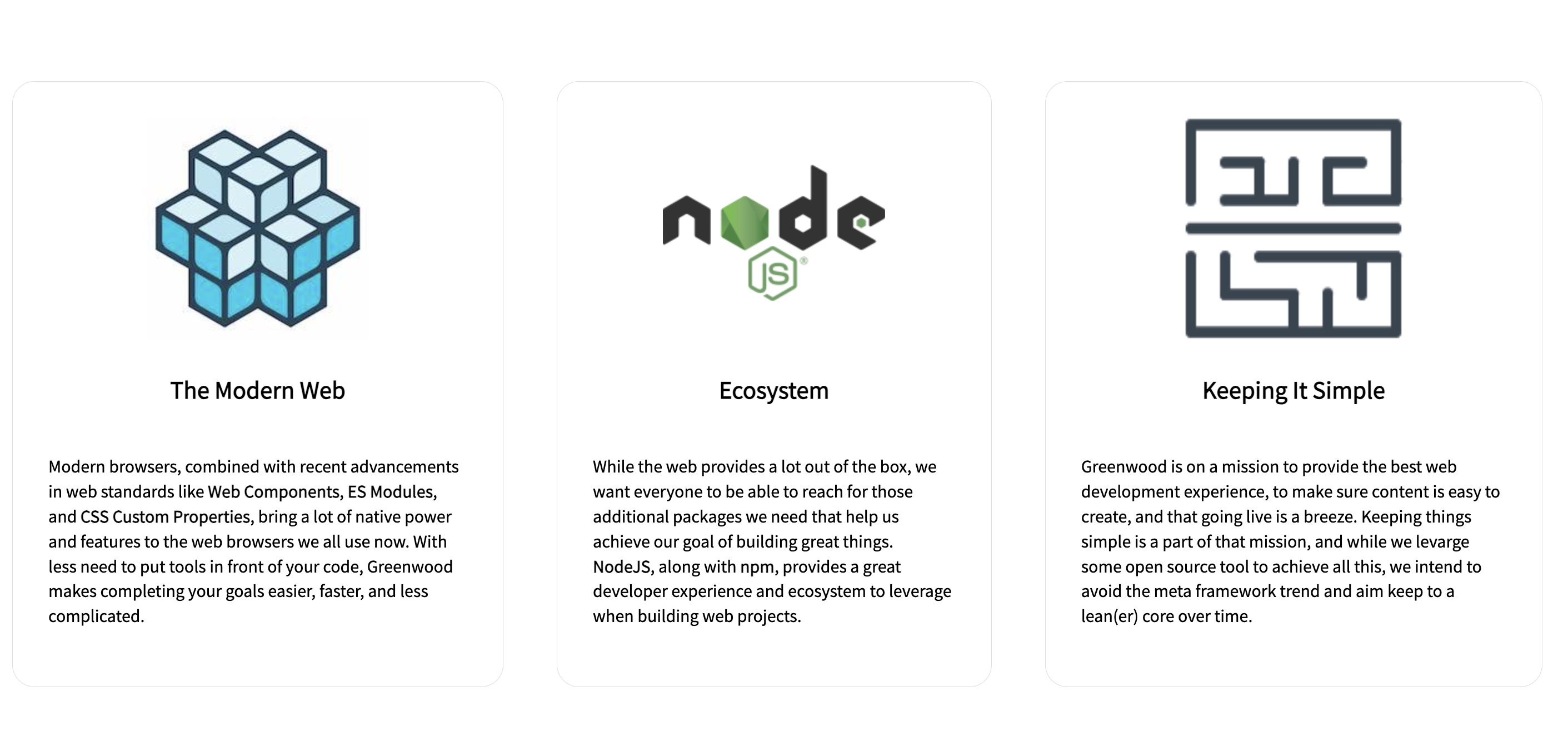The fullstack web is here
Greenwood is your workbench for the web, embracing web standards from the ground up to empower your stack from front to back.
$ npx @greenwood/init@latest
Greenwood is HTML first by design. Start from just an index.html file or leverage hybrid, file-system based routing to easily achieve static and dynamic pages side-by-side. Markdown is also supported.
- 1) HTML First
- 2) Server Side Rendering
- 3) Web Components
- 4) API Routes
Greenwood is HTML first by design. Start from just an index.html file or leverage hybrid, file-system based routing to easily achieve static and dynamic pages side-by-side. Markdown is also supported.
<!-- src/index.html -->
<html>
<head>
<title>My Site</title>
</head>
<body>
<h1>
Welcome to our site!
</h1>
<p>
Feel free to browse around or
<a href="/contact/">contact us</a>
if you have any questions.
</p>
</body>
</html>
Server rendered pages are just custom elements ("Web Server Components"), that can of course consume other Web Components for entirely standards based server-side rendering with no client-side JavaScript by default.
// pages/products.js
import '../components/card.js';
import { getProducts } from '../services/products.js';
export default class ProductsPage extends HTMLElement {
async connectedCallback() {
const products = await getProducts();
const html = products.map((product) => {
const { title, thumbnail } = product;
return `
<app-card
title="${title}"
thumbnail="${thumbnail}"
>
</app-card>
`;
}).join('');
this.innerHTML = `
<h2>Product Catalog</h2>
<div>${html}</div>
`;
}
}
Web Components are fully isomorphic in Greenwood and so the same definition can be used on the client and the server! With the power of WCC, you can use real standards based Web Components, meaning you are free to use Light DOM or Shadow DOM
// components/card.js
export default class Card extends HTMLElement {
selectItem() {
alert(`selected item is => ${this.title}`);
}
connectedCallback() {
if (!this.shadowRoot) {
const thumbnail = this.getAttribute('thumbnail');
const title = this.getAttribute('title');
const template = document.createElement('template');
template.innerHTML = `
<style>
/* Declarative Shadow DOM styles go here */
</style>
<div>
<h3>${title}</h3>
<img src="${thumbnail}" alt="${title}">
<button
onclick="this.parentNode.parentNode.host.selectItem()">
View Item Details
</button>
</div>
`;
this.attachShadow({ mode: 'open' });
this.shadowRoot.appendChild(template.content.cloneNode(true));
}
}
}
customElements.define('app-card', Card);
Include API Routes for easy client side data loading using the latest in web standards like Fetch, FormData, and Request and Response on both the frontend and the backend. You can even return HTML rendered out from Web Components. HTML, ftw!
// api/search.js
import { renderFromHTML } from 'wc-compiler';
import { getProducts } from '../services/products.js';
export async function handler(request) {
const formData = await request.formData();
const searchTerm = formData.get('term') ?? '';
const products = await getProducts(searchTerm);
let body = 'No results found.';
if (products.length > 0) {
const { html } = await renderFromHTML(`
${
products.map((item, idx) => {
const { title, thumbnail } = item;
return `
<app-card
title="${idx + 1}) ${title}"
thumbnail="${thumbnail}"
></app-card>
`;
}).join('')
}
`, [
new URL('../components/card.js', import.meta.url)
]);
body = html;
}
return new Response(body, {
headers: new Headers({
'Content-Type': 'text/html'
})
});
}
Greenwood can produce SSG, SPA, or SSR output for any static or server hosting, as well as serverless hosting providers like Netlify and Vercel.




